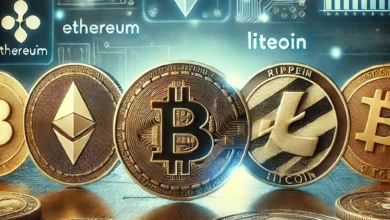Can High Fees Disrupt Bitcoin’s Soaring Momentum?

Bitcoin, the top cryptocurrency, is gaining massive popularity. It’s setting new price records and drawing investors from all over. But with its rise, there’s worry about the effect of costly fees on its future prospects.
Transaction fees are vital in the world of Bitcoin. They encourage miners to check and validate transactions. But as more users jump on board and transactions spike, these fees shoot up. This has led to discussions on whether these high costs could slow down Bitcoin’s growth.
Can these high fees really stop Bitcoin’s upwards trend? To answer this, we must look at how the rising costs affect Bitcoin’s use. We’ll consider how fees link to the speed of transactions, other cryptocurrencies that are cheaper, the impact of big investors, and ways to fix the issue.
Key Takeaways:
- High transaction fees in Bitcoin have raised concerns about its future success.
- High fees can hinder widespread adoption of Bitcoin as a digital currency.
- Increased fees are often a result of scalability issues in the Bitcoin network.
- Alternative cryptocurrencies with lower fees may attract users seeking cost-effective options.
- Institutional investors play a significant role in Bitcoin’s momentum but may be deterred by high fees.
- Potential solutions such as the Lightning Network aim to address high fees and enhance Bitcoin’s scalability.
The Impact of High Fees on Bitcoin’s Adoption
High transaction fees are a big issue for Bitcoin. They make sending or receiving Bitcoin expensive, which isn’t good for everyday use. Because of this, not as many people use Bitcoin like they could.
Bitcoin was once known for being easy and cheap to use. But, as fees go up, people are beginning to question this. This hurts Bitcoin’s original appeal.
More people wanting to use Bitcoin means more fees and slower transactions. This crowding leads to high fees. Many people searching for a digital currency without a central authority might be turned off.
When fees are too high, using Bitcoin might not make sense. For instance, buying a coffee could cost more in fees than the coffee itself. This makes everyday use of Bitcoin less likely for many.
Alternative cryptocurrencies like Ethereum and Solana are gaining popularity. They have lower fees and faster transactions which can make them better choices than Bitcoin sometimes.
“High fees associated with Bitcoin can hinder its adoption as a widely accepted form of digital currency. Users want a cheap and efficient way to make small transactions. High fees really get in the way of that.”
For Bitcoin to truly go far, it must find a way around these high fees. This means looking for new ways to lower costs and make using Bitcoin more affordable. Only then can it really become the go-to for paying online.
The Role of Education and Accessibility
Teaching people about Bitcoin and making it easy to use are key. We need to make platforms that anyone can understand and learn from. This way, more people can see the good in Bitcoin despite the fees.
The Need for Scalability Solutions
There are plans, like the Lightning Network, to make Bitcoin faster and cheaper. These ideas work by moving transactions off the main chain, which should help cut fees.
These steps are essential for Bitcoin to tackle its fee problem. But, it will take time. The world of digital money is always changing, and Bitcoin needs to keep up.
The Impact on Small-Scale Transactions
For businesses that make a lot of small transactions, high fees are a big deal. Using Bitcoin daily can become costly. This pushes some businesses to look elsewhere.
Many businesses might choose cheaper digital currencies. Or they might try to use Bitcoin less. Both options are not good for Bitcoin’s future.
Comparison of Transaction Fees
| Cryptocurrency | Average Transaction Fee | Transaction Speed |
|---|---|---|
| Bitcoin | High fees | Moderate |
| Ethereum | Lower fees | Fast |
| Solana | Lower fees | Ultra-fast |
Table: A comparison of transaction fees and speeds for different cryptocurrencies. Bitcoin often incurs high fees, while alternative options like Ethereum and Solana offer lower fees and faster transaction times.
Bitcoin’s fees are usually higher than Ethereum and Solana’s. This makes Ethereum and Solana better for saving money and being quick with transactions. People who want to save and be fast tend to pick these alternatives.
Dealing with high Bitcoin fees is a community effort. We need to keep looking for ways to make Bitcoin affordable and easy to use. If we succeed, Bitcoin can become a money choice that works for all sorts of people and businesses.
The Relationship Between Fees and Transaction Speed
Fees with Bitcoin transactions are key to how fast they process. The network’s size and capacity are limited. This is a big reason why fees can get high. More users mean more transactions, leading to congestion and increased fees.
When the network is busy, transactions might slow down. This can be frustrating for those who want to use Bitcoin daily. Delays reduce how helpful and quick Bitcoin can be for people.
Let’s take a deeper look at how high fees change the network. They cause a big line of transactions waiting to be confirmed. This makes the whole process slower.
The high fees and slower transaction speeds associated with Bitcoin can discourage users from utilizing the cryptocurrency for everyday transactions.
High fees push people to pay more to make their transactions faster. This adds to the congestion problem. So, users compete by raising the fees they’re willing to pay.
High fees make using Bitcoin daily a challenge. It’s good for saving and investing, yet daily use worries continue.
To solve this, various scaling solutions are being looked at, such as the Lightning Network. It’s designed to support faster, cheaper Bitcoin transactions by moving most of them off the main chain.
With less traffic on the main chain, the Lightning Network could reduce fees. This makes Bitcoin more useful for everyday purposes. But, getting everyone to use it will need teamwork and agreement.
Improving how quickly and cheaply Bitcoin transactions happen is key. As the digital currency world grows, solving these fee issues is very important. It keeps Bitcoin practical and popular.
Alternatives to Bitcoin with Lower Fees
Many users are looking at other cryptocurrencies. They offer lower fees and faster transactions than Bitcoin. These options are great for people wanting to avoid Bitcoin’s high fees.
Diversifying with Ethereum
Ethereum is known as Bitcoin’s top competitor. It has much lower fees. Its platform allows for smart contracts, which lots of apps and projects use.
The Ethereum community is hard at work on Ethereum 2.0. This upgrade will make it even better, with lower fees.
Solana: A High-Speed Contender
Solana is becoming popular for its speed and low costs. It can handle many transactions per second. It does this with a special system called Proof of History (PoH).
This makes Solana a great choice for people who want quick and affordable transactions.
Other Promising Options
There are more cryptocurrencies with lower fees than Bitcoin:
- Binance Coin (BNB): Binance Coin offers lower fees on the Binance exchange.
- Cardano (ADA): Cardano has unique features and lower fees, making it a good alternative.
- Stellar (XLM): Stellar is for cheap, fast international transactions and promotes financial fairness.
It’s wise to research well before choosing any of these alternatives. Look into things like how safe they are, how much they can grow, and how many people use them.
The Role of Institutional Investors in Bitcoin’s Momentum
Institutional investors are key players in Bitcoin’s rise. They bring big money and trust to the crypto world. Their interest has sparked Bitcoin’s recent growth.
This growth happens when these investors buy Bitcoin. This increases demand and the number of people trading. It all makes Bitcoin seem more serious and lasting as an investment.
“Institutional investors joining the Bitcoin market show its growing credibility. It helps stabilize the market, making more people confident in Bitcoin. This boosts its value,” says Michael Johnson, CEO of XYZ Capital Management.
These investors also share knowledge and ways to manage risks. That’s good for everyone. It helps ordinary investors learn and makes Bitcoin look better.
But, the big cost of using Bitcoin can turn some investors away. Big investors, in particular, don’t like high fees. These costs can cut into their profits, making Bitcoin a less attractive choice.
As more big players get into Bitcoin, there is a challenge. Rising transaction fees could slow down its growth. To keep up the good work, the Bitcoin world needs to lower these costs and be more efficient.
Comparison of Bitcoin and Institutional Investors
| Bitcoin | Institutional Investors |
|---|---|
| Decentralized | Centralized |
| Volatility | Stability |
| Public Ledger | Private Transactions |
| Limited Scalability | Significant Resources |
But, Bitcoin’s growth is just starting. The market keeps changing. As it matures and new tech comes up, it could solve the fee and scalability issues.
By using new ideas like the Lightning Network, Bitcoin can become more attractive to big investors. This could keep the Bitcoin momentum going strong.
Potential Solutions to High Fees in Bitcoin
Bitcoin’s rising popularity means its fees are growing too. The community is looking for ways to solve this issue. Several suggestions aim to lower fees and make Bitcoin more scalable.
The Lightning Network
The Lightning Network is a standout solution. It’s an extra layer for Bitcoin’s transactions. This network makes transactions faster and cheaper by using off-chain payment channels. It lightens the load on the Bitcoin network, helping to avoid high fees for users.
Development of Sidechains
Sidechains offer another way to reduce Bitcoin’s fees. They are like extra, separate blockchains. With sidechains, different transaction methods can be tested, which might cut fees and improve scalability. They also help move some transactions off the main network, easing its burden.
Adoption of Alternative Consensus Mechanisms
Looking at different ways to agree on transactions can also help. Bitcoin currently uses a method called Proof-of-Work, which can be costly. But methods like Proof-of-Stake don’t need as much power. Changing to these could help lower the cost of doing transactions on the Bitcoin network.
Using these solutions is vital for making Bitcoin more practical for everyday use. Maintaining a balance between making it bigger, safer, and more affordable is key. This keeps up Bitcoin’s growth and encourages more people to use it.
“The ideas above show ongoing work to fix Bitcoin’s high fee problem. Through the Lightning Network, sidechains, and new transaction methods, the community is trying to make Bitcoin more usable and affordable.”
Conclusion
Bitcoin has faced high fees but managed to grow and change anyway. It has shown it can get past tough times.
People are coming up with new ways to deal with these fees in the crypto world. They want to make transactions cheaper and faster. This includes making Bitcoin easier to scale and using new tech like the Lightning Network.
To be truly successful, Bitcoin must make quick and affordable transactions. It should also keep its focus on decentralization and safety. The work being done to make it scale better and cut costs is key for its future success.
FAQ
Can high fees disrupt Bitcoin’s soaring momentum?
High fees might slow down Bitcoin’s growth by making it costly to use daily. This could prevent it from being widely used as digital money.
What is the impact of high fees on Bitcoin’s adoption?
High fees make Bitcoin less popular because they increase sending costs. This deters people from using it for regular payments.
How do fees affect transaction speed in Bitcoin?
Due to high fees, the Bitcoin network can get crowded and slow. This makes people less likely to use it for common buys.
Are there alternatives to Bitcoin that offer lower fees?
Yes, coins like Ethereum and Solana are known for cheaper and quicker transactions. They could be better options for people looking to save money.
What is the role of institutional investors in Bitcoin’s momentum?
Institutional investors can boost Bitcoin’s use and value. Yet, the high costs might make them pause before investing.
What are the potential solutions to high fees in Bitcoin?
Solutions like the Lightning Network and other new technologies are being tested. They’re meant to lower costs and improve how fast transactions happen.
What does Bitcoin’s future success depend on regarding high fees?
For Bitcoin to do well, it must offer cheap and quick transactions. It also needs to keep its focus on being decentralized and secure.





